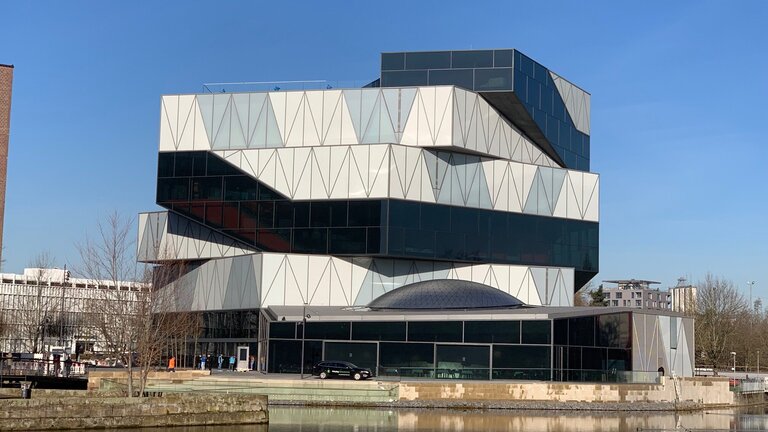On a Voyage of Discovery Through the Futuristic Building
How does it feel to be in the eye of the storm? What would your body look like if it turned into ice or rubber? What is it like to paraglide over mountains? Experiencing science with all the senses is what experimenta Heilbronn is all about. Close to the city center, visitors of all generations can enter a world of discovery, experiences and research. Managing Director Dr. Wolfgang Hansch explained: ‘We felt it was important to make experimenta Heilbronn a place where people can learn something about themselves and stimulate and satisfy their curiosity about natural sciences, technology, and digital transformation, and be able to discuss moral and ethical issues.’ One of the special features of experimenta is the Science Dome, which is a combination of a planetarium, a 3D cinema and a performance space for experimental theatre. It offers a 180-degree rotatable auditorium for shows, with a curved screen as well as an observatory. All of this is housed in a new five-story building of extraordinary architectural design, in combination with the redesigned original building.
Drees & Sommer Uses Digital Method to Manage Construction Project
What is innovative is not only the unusual design of the building, in which the storeys are rotated individually to form a spiral shape, but also the fact that Building Information Modelling (BIM) was used for the planning and construction phases of the project. Drees & Sommer took advantage of the many benefits of this digital planning method, as well as fully integrated 3D planning, to manage the new build for experimenta from the start of the project. The objective of BIM is to efficiently organize complex construction projects and the future operation of the building in the planning and construction phases.
This enables simulation of the later operation of the building and facilitates decision-making processes. The big advantage of this way of proceeding is that BIM can use the database to show in realtime the impact in terms of quality, cost, time, and the environment and share the information with all stakeholders. With good-quality data, conflicts and errors can be avoided at an early stage.
Efficiency Thanks to BIM und Modular Construction
Mirco Beutelspacher, Partner at Drees & Sommer SE, explained: ‘We are delighted to have been able to oversee this flagship project of the Dieter Schwarz Foundation from the design process through to completion. It was very important to us that we were making a contribution to the experimental education of children and young people through digital innovation.’ With Building Information Modeling, you build twice – once virtually, and once in reality. In line with this principle, BIM was used for experimenta from the basic design stage. The complex new build was captured in digital form in the BIM model and broken down into planning modules. The experts optimized the façade construction in such a way that, of the more than 200 different façade elements existing at the start, approximately 50 were left at the end. Despite the complex architecture, with digital modularization the specialist engineers succeeded in developing a large number of façade elements that are repeated. This enabled them to reduce the logistical complexity and speed up the construction process while work was in progress. Energy simulations and cost-benefit analyses with the aid of the data model also revealed the most efficient energy concept: a combination of groundwater, heat pump technology and natural gravity cooling systems.
